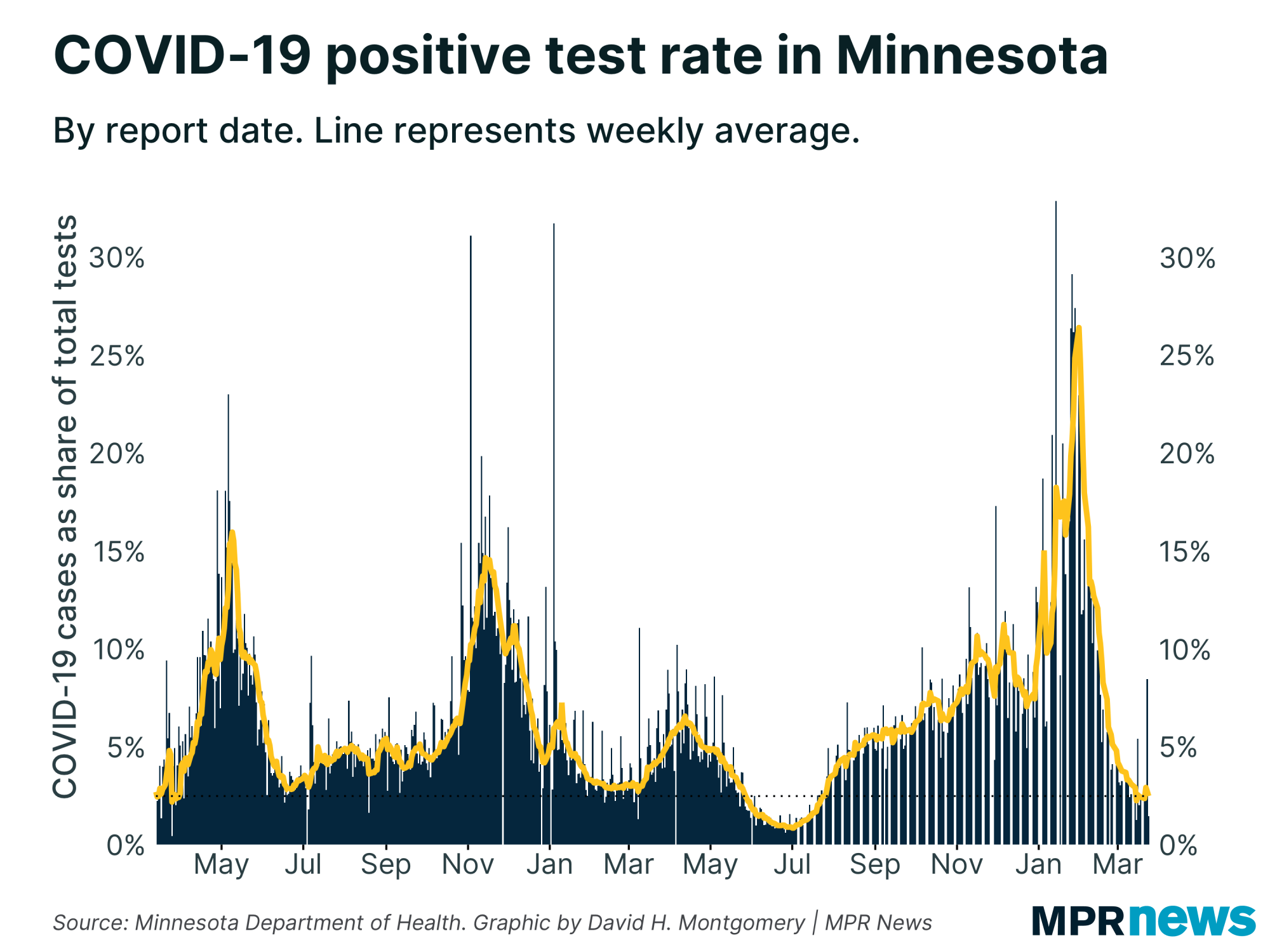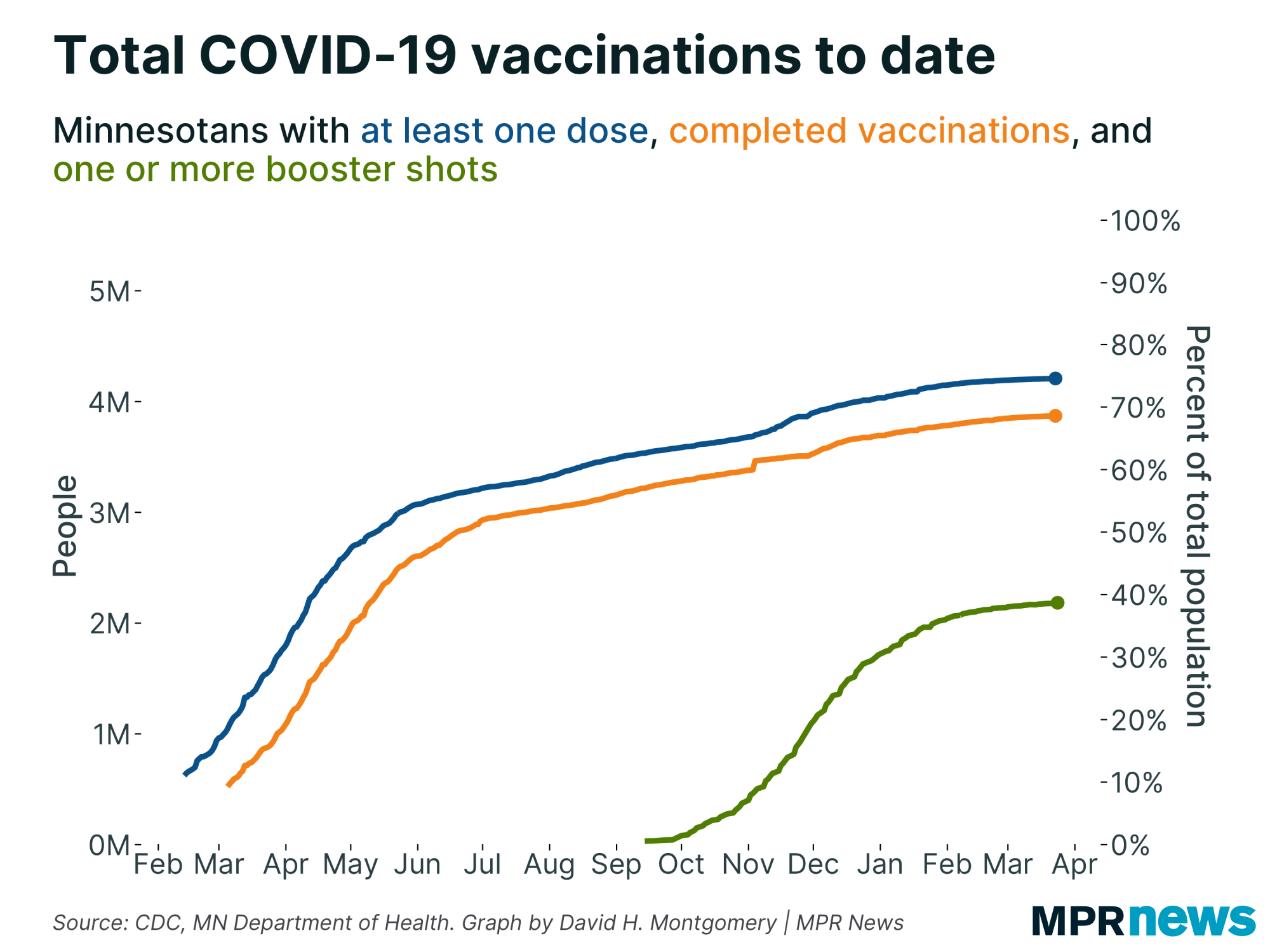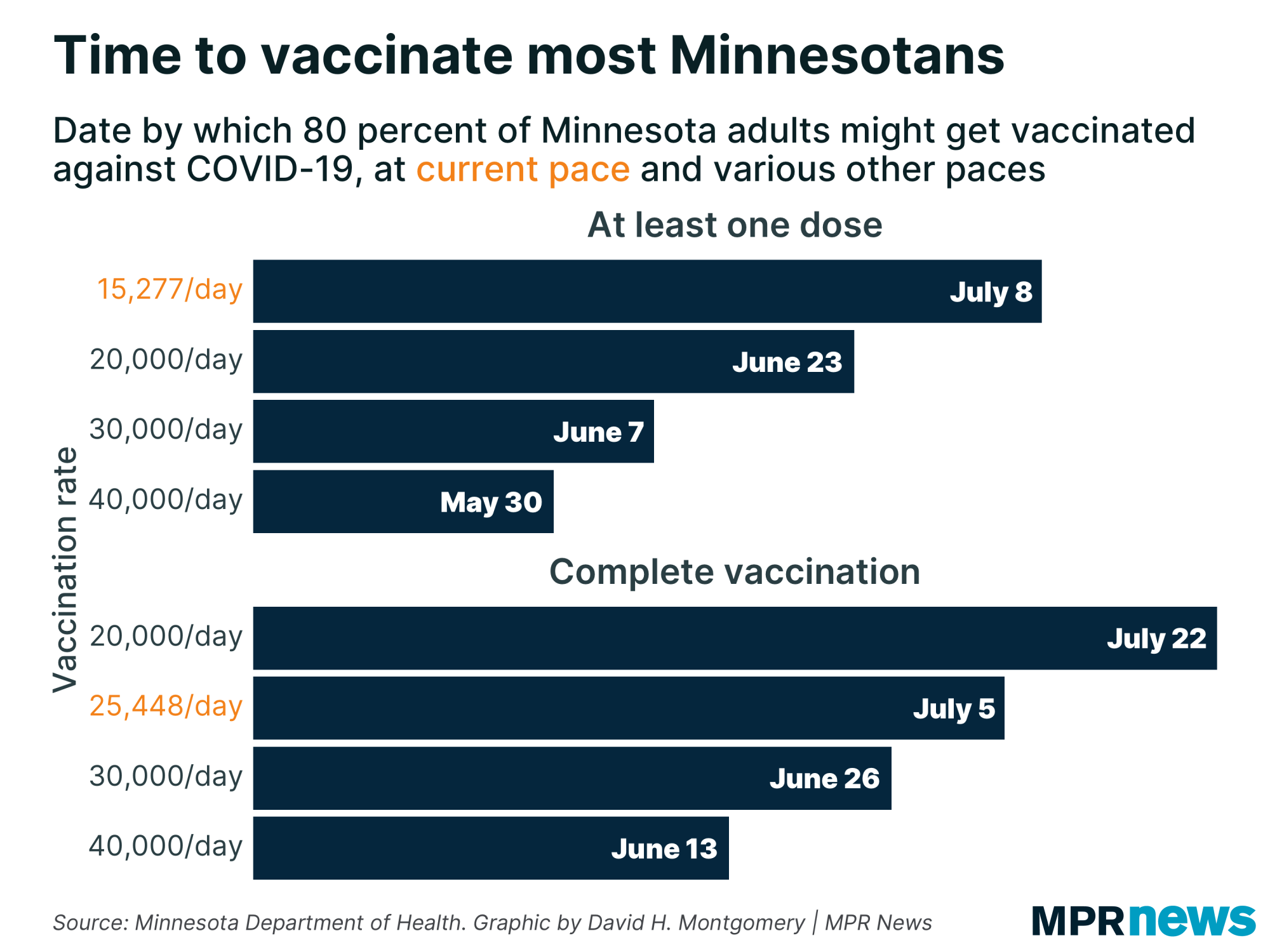April 29 update on COVID-19 in MN: Cases trending down; vaccination urgency remains

Go Deeper.
Create an account or log in to save stories.
Like this?
Thanks for liking this story! We have added it to a list of your favorite stories.
3 things to know
Active cases trending down, vaccination pace flattening; officials plead for vigilance against the disease amid spring events
Most of new cases tied to more contagious variants
22 cases confirmed linked to recent protests
Updated: 5:56 p.m.
Minnesota’s COVID-19 picture continues to improve, with cases and hospitalizations trending down off the top of a recent wave. Officials, though, remain concerned about the flattening pace of vaccinations — and that some Minnesotans are late for their second shot.
Public health leaders continue to urge Minnesotans to keep their guard up during proms, graduations and other spring events to protect against spreading the disease, noting that more contagious COVID-19 variants are driving new cases across the state. One of them, known as the U.K. variant, is the dominant strain in the state, making up 60 to 70 percent of new cases, officials said.
Minnesota has also seen small but growing numbers of other variants: 88 cases of the South African variant and 65 cases of the Brazilian variant. State infectious disease director Kris Erhesmann said the average age for cases of both of those variants is 37.
Officials on Thursday also said they’ve confirmed 22 COVID-19 cases linked to recent protests in Brooklyn Center over the police killing of Daunte Wright. Half of those cases were found among law enforcement. The Health Department urged anyone at the protests to get tested.
Turn Up Your Support
MPR News helps you turn down the noise and build shared understanding. Turn up your support for this public resource and keep trusted journalism accessible to all.
Overall, conditions in Minnesota have improved to the point that Gov. Tim Walz is expected to loosen more restrictions on public gathering places, likely next week.
“The impact of the variants remains a wild card,” Minnesota Health Commissioner Jan Malcolm told reporters Wednesday. “We’re certainly hopeful with the recent apparent kind of leveling off in the case rates, although still at a very high level. We’re certainly not declaring victory yet.”
Active cases trending down
The count of known, active cases came in at 14,741 in Thursday’s numbers, slightly higher than the prior day but still down from the most recent peak of about 20,000 in mid-April. The seven-day trend line is at its lowest point in more than three weeks.

Given the state’s vaccination efforts, officials said they didn’t expect this spring wave would match the 50,000 active cases seen at the top of the late November surge, but they remained worried given the rise in new COVID-19 strains.
The percentage of COVID-19 tests coming back positive continues to dip after a recent upswing and remains just below the 5 percent threshold that experts find concerning.

Hospitalizations had been climbing the past few weeks, hovering at levels not seen since January.
Thursday’s numbers showed 644 people hospitalized with COVID-19 in Minnesota; 176 needed intensive care. Both figures are down from the prior week. Hospitalizations can often stay higher for several weeks following an increase in active cases.
Fifteen deaths reported Thursday brought Minnesota’s pandemic toll to 7,128. Among those who have died, about 61 percent had been living in long-term care or assisted living facilities; most had underlying health problems.

The state has recorded 573,938 total confirmed or probable cases so far in the pandemic, including the 1,921 posted Thursday. About 96 percent of Minnesotans known to be infected with COVID-19 in the pandemic have recovered to the point where they no longer need to isolate.

Regionally, all parts of Minnesota are in better shape than they were in late November and early December. Case counts had been creeping up the past few weeks across the state, but the trend appears to have peaked.

Vaccination pace leveling
Minnesota’s vaccination pace remains relatively flat as officials work now to reach out to those who haven’t been vaccinated.
More than 2.5 million residents 16 and older now have at least one vaccine dose, and more than 1.8 million have completed their vaccinations, as of Wednesday’s update.
That works out to about 42 percent of the 16-and-older population completely vaccinated and 57 percent with at least one shot, including about 87 percent of those 65 and older.

The state’s vaccination efforts have been hampered the past few weeks by supply cuts, particularly of the Johnson & Johnson vaccine, which federal authorities paused earlier this month as they investigated the possibility of rare side effects associated with the shot.
The pace may pick up, after federal health officials lifted the pause on using the Johnson & Johnson vaccine. But the recent production breakdown that resulted in millions of J&J doses ruined is having an impact.

Officials also acknowledge the state must do more to connect unvaccinated people to shots.

The Health Department estimates about about 3.4 percent of Minnesotans who’ve received their first dose of a two-dose regimen are late for their second shot. Nationwide, about 8 percent of Americans have skipped out on their second dose, according to the Centers for Disease Control and Prevention.
Out of more than 1.2 million Minnesotans completely vaccinated with two weeks logged beyond the last dose, officials say they’ve confirmed just a sliver, 1,163 cases, where a completely vaccinated person became infected with COVID-19.
Youth counts concerning
While the numbers are improving, officials continue to emphasize the pandemic is not over.
Minnesota officials say they want more testing of middle and high school students because they’re increasingly concerned about the spread of COVID-19 in younger people, particularly those playing youth sports.
State health and education officials have posted updated guidance urging athletes, coaches, referees, volunteers and other youth sports participants to get tested weekly for COVID-19.
Students not participating in sports or other group activities are “still strongly encouraged” to test every two weeks, they said. Middle and high schools are being advised to offer on-site testing.
People in their 20s still make up the age bracket with the state’s largest number of confirmed cases — more than 106,000 since the pandemic began.
The number of high school-age youth confirmed with the disease has also grown, with more than 46,000 15-to-19-year-olds known to be infected during the pandemic.
Although young people are less likely to feel the worst effects of the disease and end up hospitalized, experts worry they will spread it unknowingly to older relatives and members of other vulnerable populations. Those with the COVID-19 virus can spread it when they don’t have symptoms.
People attending proms, graduations and other youth oriented events are special concern now for health officials.
The work by schools and districts to build safeguards into those events “can be completely undermined if students and parents don’t do their part, as well,” Ehresmann told reporters Thursday.
Officials confirmed their comments were motivated partly by photos of a prom in southwestern Minnesota where many people were not masked.
“These kinds of events are ripe for spread” unless people take precautions, Malcolm said.
Latest developments
2 Minnesota private colleges to require COVID vaccinations this fall
Carleton College in Northfield, Minn., announced Wednesday that the school will require students and staff to be vaccinated against COVID-19 this fall, in addition to flu vaccinations.
Macalester College in St. Paul made a similar announcement earlier this month. That school's president, Suzanne Rivera, says their decision was easy.
“We want our classrooms full. We want indoor choir practices. We want spectators at athletic contests. We want to be able to have roommates in dormitories,” she said.
Both schools say they will allow very limited exceptions.
— Tim Nelson | MPR News
Walk-in vaccinations now available at fairgrounds
Health officials say they're opening up COVID-19 vaccinations at the State Fairgrounds.
The mass vaccination site has already been offering appointments for people in surrounding ZIP codes. But a spokesperson for the State Department of Health says the site is now taking walk-ins for first doses without appointments through May 4. Eligibility is no longer limited by ZIP code.
The fairgrounds previously limited walk-ups to just 100 a day, but now has no limit beyond the 2,000 daily doses it has available.
— Tim Nelson | MPR News
Top headlines
Survey finds student learning, mental health suffered during pandemic: A new survey finds that Minnesota students in grades 6 through 12 managed to learn despite dramatic pandemic-related school changes. But their rate of learning was perceived to be lower than before COVID-19 and their mental health was challenged.
The risk of COVID-19 spread for children and students: Minnesota health officials are urging more testing of middle and high school students for COVID-19. They're increasingly concerned about spread of the virus among children who are not yet authorized for the vaccine. This sets up a tough dynamic for parents. It can be hard to know how safe certain activities are for the family, if not everyone is immunized.
Benefits outweigh the risks of Johnson and Johnson vaccine, Dr. Hallberg says: Officials at the U.S. Centers for Disease Control and Prevention have allowed providers to resume administering the one-dose vaccine, after reviewing the rare risk of blood clots associated with it.
Pandemic-fueled surge in visitation to BWCA expected to continue this year: Amid COVID-19, more than 165,000 people visited the Boundary Waters last year — a 16 percent jump over the previous year — as people sought refuge in the isolated wilderness from the pandemic. Outfitters say early reservations suggest this summer could be even busier.
COVID-19 in Minnesota
Data in these graphs are based on the Minnesota Department of Health's cumulative totals released at 11 a.m. daily. You can find more detailed statistics on COVID-19 at the Health Department website.


